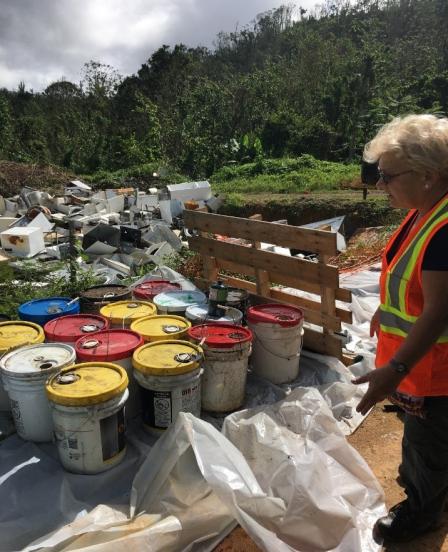News Releases from Headquarters›Land and Emergency Management (OLEM)
EPA Hurricane Maria Update for December 18, 2017
WASHINGTON (December 18, 2017) – The U.S. Environmental Protection Agency continues its response to Hurricanes Irma and Maria in close coordination with other federal agencies and our commonwealth, territorial, and local partners. EPA continues its work to address drinking water and wastewater needs in Puerto Rico and the U.S. Virgin Islands and has made great inroads in the collection of household hazardous waste, recovery of sunken vessels and debris management.
“EPA is fully engaged with communities throughout Puerto Rico and the U.S. Virgin Islands as they recover from the destruction of Hurricanes Irma and Maria,” said EPA Regional Administrator Pete Lopez. “As we near the four-month mark in our response efforts, our commitment to the citizens of Puerto Rico and the USVI remains strong, with nearly 400 EPA personnel working to bring drinking water laboratories back on line, collecting nearly 70,000 containers of hazardous materials, responding to oil spills and addressing sewer and drinking water infrastructure problems in remote locations.”
Personnel
As of December 18, 2017:
• About 390 EPA personnel are currently involved in hurricane response efforts.
• About 138 EPA personnel are on the ground in USVI to assist with response efforts.
• About 157 EPA personnel are on the ground in Puerto Rico to assist with response efforts.
Debris Management and Hazardous Household Materials
Hurricanes generate vast amounts of debris. Hurricanes Irma and Maria generated enough debris to fill Yankee stadium seven times. It’s important for EPA to help maximize recycling efforts and manage hazardous waste appropriately by segregating debris piles. EPA is assisting with the management of this debris, including the handling and disposal of household hazardous waste, oil, chemical, medical, and electronic wastes.
EPA is working closely with FEMA, the U.S. Army Corps of Engineers and local governments to open and operate collection areas for hazardous household materials.
Nearly 70,000 containers of HHW and orphan containers, white goods and e-waste items, have been collected to date. In the USVI, large quantities of medical waste are being managed. Information about HHW segregation, drop-off and/or collection is being disseminated to residents through flyers, public service radio announcements, and direct interaction by EPA personnel at heavily frequented locations, such as shopping centers. Orphan containers include drums, tanks, fluid totes, compressed gas cylinders, canisters and similar containers found floating in or washed up near waterways. EPA has also assisted in packaging, shipping and disposing many tons of medical waste from the hospitals and medical centers in the USVI.
Household hazardous waste includes aerosol cans, household cleaners and chemicals, paint, and electronic waste such as computers and televisions. Household hazardous materials also include batteries, which have become a major concern due to the large volume of batteries being used by residents who are without power. Household hazardous waste can contaminate the land, waterways, and groundwater if improperly disposed.

EPA continues its outreach to communities to collect post-hurricane hazardous household waste in Puerto Rico and the U.S. Virgin Islands. (Barranquitas, Puerto Rico). Photo: Courtesy of U.S. EPA
Marine Operations
EPA continues to support the U.S. Coast Guard in the recovery of submerged or damaged vessels in Puerto Rico and the USVI. EPA is part of multi-agency field teams, which are locating and evaluating the condition of sunken vessels. EPA is assisting with the disposal of recovered oil, batteries and hazardous materials. To date, EPA and the U.S. Coast Guard have assessed 364 vessels in Puerto Rico. In the USVI, 467 vessels have been assessed.
Drinking Water and Wastewater Management
EPA is continuing to assess the conditions of drinking water, including sampling, analysis and lab support. EPA is also assisting federal, state and local agencies to assess and identify needed repairs to wastewater conveyance and treatment systems. The Puerto Rico Aqueduct and Sewer Authority (PRASA) and the Puerto Rico Department of Health continue to monitor drinking water quality to ensure that PRASA’s drinking water supplies meet local and federal drinking water standards.
In addition to coordination with governmental entities, EPA has partnered with the non-governmental organizations Water Mission, Samaritan’s Purse, Project Hope, and RCAP Solutions to assist the estimated 76,000 Puerto Rico residents in over 200 communities across the island that rely on drinking water sources from pumps and wells and surface water that are not supplied by the Puerto Rico Aqueduct and Sewer Authority (PRASA). Approximately 237 of these small systems, commonly known as non-PRASA drinking water systems, provide drinking water to approximately three percent of the population of Puerto Rico. Government and non-governmental organizations are working together to repair damaged systems to provide generators and, in some cases, solar power to these systems. To date, solar panels have been installed on about four of these community drinking water systems with four more planned for completion before Christmas.
EPA completed nearly 1,400 drinking water assessments in the USVI. EPA is continuing to sample drinking water systems identified by DPNR in St. Croix. EPA will continue to coordinate with DPNR to prioritize drinking water facilities to be assessed and sampled.
Water Safety
In general, and out of an abundance of caution, EPA and local government agencies in Puerto Rico continue to recommend that people take precautions when coming in direct contact with waterbodies in Puerto Rico, including streams, rivers, and beaches because of the possibility of raw sewage being discharged into some water bodies.
Contaminated water can lead to illness when used for drinking, bathing, and other hygiene activities. For information on making water safe in an emergency, go to the Center for Disease Control and Prevention’s Making Water Safe in an Emergency web page.
For more information and photos, visit EPA’s Hurricane Maria website and our Hurricane Maria Story Map.
Hurricane Maria Site:
https://response.epa.gov/site/site_profile.aspx?site_id=12403
Hurricane Maria Story Map:
https://epa.maps.arcgis.com/apps/MapJournal/index.html?appid=051533ab716c4f5e821dc361cbb1876f
# # #
